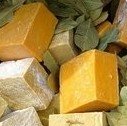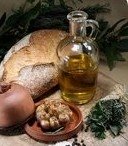Sourdough Bread
Sourdough bread is based on a fermented yeast 'starter' mixture which you can keep working by replenishing it with a little from each new batch of dough that you mix up. Sourdough bread, while not exactly 'sour', does have a distinctive tangy flavor.
For the starter you will need:
1 tablespoon dried yeast
2 1/2 cups warm water (boiled first and then cooled)
2 teaspoons sugar
2 1/2 cups wholemeal flour
Mix this together in a glass jar, or bowl and let it stand at room temperature for 5 days to ferment. Stir it every day and after this time, store it in the refrigerator, stirring when liquid rises to the top. The starter will produce the best bread if used once a week.
Bread recipe for 2 loaves: The night before you want to bake the bread, mix together in a large bowl:-
1 cup of starter
4 1/2 cups wholemeal flour (or) 2 1/2 cups wholemeal and 2 cups white flour.
3 1/2 cups lukewarm water
Beat this all together well, cover and leave to stand overnight. In the morning, take out 1 cup of the batter and add it to the starter mixture in the fridge.
You will now need:
1/2 cup oil
1 tablespoon salt
5-6 cups wholemeal flour (or) 4 cups wholemeal and 1- 2 cups white flour
1. Mix the oil and salt into the batter. Add enough flour until the dough can be kneaded. (It will be a little more sticky than the usual bread dough.)
2. Turn out onto a floured board and knead for 10 minutes.
3. Halve the dough, shape it and place into oiled bread tins. Cut one lengthwise slit or 3 diagonal slits on the top of each loaf with a sharp knife. Cover the loaves with plastic wrap or a damp cloth and leave to rise for about 2 hours, until just rounded above the tops of the tins.
4. Brush the loaves with water before placing them in a preheated oven at 220°C. After 20 minutes at this temperature, lower the heat to 190°C and continue baking for 50-60 minutes. During baking you may have to cover the loaves loosely with foil if they are browning too quickly.
4.To test to see if the loaves are cooked, turn one out onto a board and tap the bottom. If it sounds hollow, then they are done. If not, return to oven for a little longer.
Did you find this page helpful?
Sharing is a way of saying, "Thanks!"
Follow Us and Keep Up to Date
Go back to the Home Page





